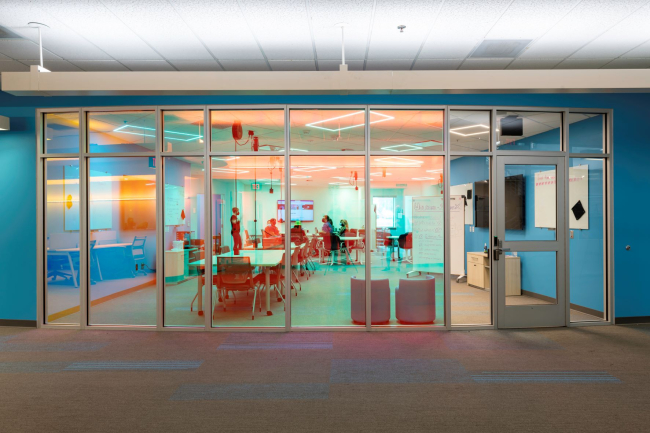
It’s official—the soft launch period for Studio X, the University of Rochester’s hub for extended reality (XR), is over, and a new era is set to begin. During Meliora Weekend, on September 30, a dedication ceremony will mark the grand opening of Mary Ann Mavrinac Studio X.
Mary Ann Mavrinac is vice provost & Andrew H. and Janet Dayton Neilly Dean Emeritus of the University of Rochester Libraries. Mavrinac’s leadership from 2012 to 2022 drove the realization of collaborative and innovative spaces, including Evans Lam Square, the Barbara J. Burger iZone, and Studio X. She became the namesake of Rochester’s XR space as part of a giving challenge created by University Trustee Evans Lam ʼ83, ʼ84S (MBA). The celebration later this month will honor Mavrinac and recognize Lam and other donors whose support helped establish a strong foundation for the physical space and corresponding program.
But before there were gifts or grants of any kind, there was a need that now represents the core of Studio X’s existence.
Why Studio X?
Lauren DiMonte, now associate dean of Learning, Research, and Digital Strategies, was interviewing faculty in 2018 about pain points to see if there were areas where the library could help. Faculty members across disciplines kept talking about similar challenges when working with augmented and virtual reality:
- The technology is expensive, and the pace of change made purchasing it impractical.
- The work requires interdisciplinary expertise and support, so it would be easier and more beneficial to have a central location where people could meet, collaborate, and access the technology.
- Students are unprepared for upper-level courses in XR and need a way to be introduced to the technology and platforms sooner.
At the time, Rochester had more than 50 researchers—from the Medical Center, Eastman School of Music, Warner School of Education and Arts, Sciences, & Engineering—working in XR. Given their shared struggles, it made sense to build a central program and space to provide the necessary support. As the support system for all University teaching, learning, and research, the library was a natural fit.
DiMonte ran a series of charrettes to learn what prospective users needed from an XR space. Four basic needs emerged:
- A space that feels welcoming to all
- Expertise that lowers the barriers to entry
- Technology that stays current
- A community that fosters collaboration
“Nearly four years later,” says Emily Sherwood, director of Studio X and Digital Scholarship, “the requests we receive from our community and the things they want continue to echo the original needs.”
XR IRL
Meliora Weekend attendees will have the opportunity to see what an XR hub looks like in real life (IRL) at a special Studio X open house following the dedication ceremony.
For anyone looking for reasons to stop by, here are three, with some context provided by Sherwood.
Meet the experts
“Our team comprises full-time staff, XR specialists, and Karp Library Fellows. They’re thoughtful, creative, intelligent, kind, and fun. They’re also passionate about XR and helping others learn about it. They design and run our workshops, help with classes, and troubleshoot questions related to a range of XR topics, technologies, and programs.”
Explore the vibe
“Although we’re still in the early stages of Studio X, I’m proud of the community that we’ve built in a short amount of time. There was a strong desire for a place where faculty, students, and staff could meet others interested in XR, learn about new approaches and technology, and brainstorm ways to collaborate and innovate together.
Our team fosters a sense of community through formal and informal programming and course integrations. They suggest collaborative events with other programs and organizations, and they work with faculty across disciplines interested in incorporating XR in their teaching and research. Whether you want to host an open house for your club or design a research project, you can find help at Studio X.”
Experiment with the tech
“XR technology is changing at such a rapid pace, it’s hard to keep up. But that’s also the fun of it: there is always something to learn. We regularly research and test new equipment and experiences. We also encourage our community to recommend technology for our lending library.
For example, this summer, we purchased a Valve Index, suggested by Liam O’Leary, one of our Karp Library Fellows. The Valve Index is a high-end tethered headset (as opposed to untethered headsets like the Meta Quest 2 or Hololens) that allows you to experiment with more immersive XR experiences with higher graphical fidelity and a focus on realism.
And there’s the stuff we hope to get in the future. Many of our students are interested in haptics, which provide more accessible and full-body experiences. Haptic gloves and a 360-degree treadmill are examples of equipment we would love to add to our existing resources.” ∎
For more information on Studio X, contact Emily Sherwood at esherwood@library.rochester.edu. To have a conversation about supporting Studio X, contact Pamela Jackson, senior director of Advancement for the River Campus Libraries, at pamela.jackson@rochester.edu.
Enjoy reading about the University of Rochester Libraries? Subscribe to Tower Talk.

